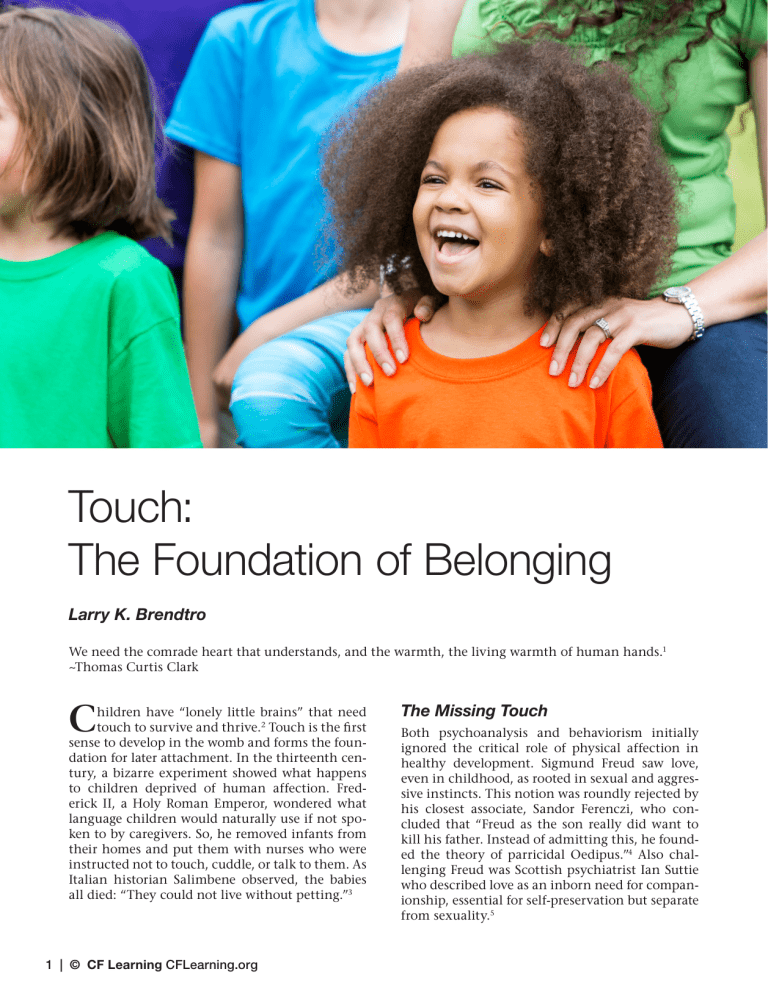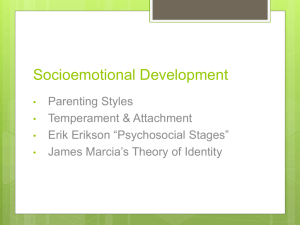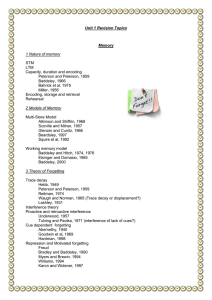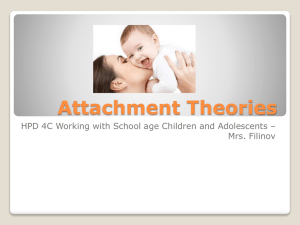Touch is Foundation-of-Belonging
advertisement

Touch: The Foundation of Belonging Larry K. Brendtro We need the comrade heart that understands, and the warmth, the living warmth of human hands.1 ~Thomas Curtis Clark C hildren have “lonely little brains” that need touch to survive and thrive.2 Touch is the first sense to develop in the womb and forms the foundation for later attachment. In the thirteenth century, a bizarre experiment showed what happens to children deprived of human affection. Frederick II, a Holy Roman Emperor, wondered what language children would naturally use if not spoken to by caregivers. So, he removed infants from their homes and put them with nurses who were instructed not to touch, cuddle, or talk to them. As Italian historian Salimbene observed, the babies all died: “They could not live without petting.”3 1 | © CF Learning CFLearning.org The Missing Touch Both psychoanalysis and behaviorism initially ignored the critical role of physical affection in healthy development. Sigmund Freud saw love, even in childhood, as rooted in sexual and aggressive instincts. This notion was roundly rejected by his closest associate, Sandor Ferenczi, who concluded that “Freud as the son really did want to kill his father. Instead of admitting this, he founded the theory of parricidal Oedipus.”4 Also challenging Freud was Scottish psychiatrist Ian Suttie who described love as an inborn need for companionship, essential for self-preservation but separate from sexuality.5 The founder of behaviorism, John Watson, warned parents to avoid hugging their child—simply give a handshake or pat on the head as a reward for good behavior.6 Watson’s theory mirrored his own love-deprived childhood.7 His mother imposed harsh religious training and his alcoholic playboy father abandoned the family to cohabit with two women. As a rebellious teen, John was a poor student and twice arrested for delinquency. But Watson channeled his own lack of affection into gaining recognition through achievement—a plan he prescribed for all children. He contended that a youngster reared with minimum affection “finally enters manhood so bulwarked with stable work and emotional habits that no adversity can quite overwhelm him.”8 Ironically, the opposite is true: five decades of research show that resilience develops through relationships of receiving and giving love.9 Attachment theory, pioneered by John Bowlby and Mary Ainsworth, has transformed our understanding of the power of close human relationships.15 When John Bowlby graduated from Cambridge in 1928, he began volunteer work at a school for maladjusted children. Two youngsters he encountered would shape his professional career.16 An anxious eight-year-old boy trailed Bowlby everywhere and was known as his shadow. The second, an affectionless teen, had been expelled from his previous school for theft and had no stable parenting. These experiences propelled Bowlby into child psychiatry and inspired his early book, Forty-four Juvenile Thieves: Their Characters and Home Life.17 Over the next decades, attachment researchers drew knowledge from many fields to produce the most impressive body of scientific evidence in the realm of developmental psychology.18 Pioneering Research on Touch Bowlby’s most influential associate was Mary Ainsworth of the University of Toronto who conducted classic studies of child care in Uganda. She also developed the Strange Situation method of research, studying the behavior of small children briefly separated from mother and left with a stranger. The child’s reactions upon return of the mother were used to identify those with secure attachment, in contrast with children showing insecure attachment through anxious or avoidant behavior.19 Extensive research shows the style of attachment established in infancy can become the prototype for future relationships with one’s own children, spouse, kin, and friends.20 Resilience develops through relationships of receiving and giving love. Serious scientific study of the power of touch began in the mid-twentieth century. René Spitz conducted careful observation of children in a German orphanage who were clean and well-fed but lacked physical touch; they became listless and many died even though their physical needs were met. He compared these children with a second group of infants who were reared in a prison nursery but had regular contact with their inmate mothers and prison staff.10 Although locked up along with their moms, these wellnurtured infants thrived. A fascinating film of Spitz’s classic research is available on line.11 But despite such science, the tragedy of touch deprivation would be repeated in Romanian orphanages.12 Inspired by Spitz, Harry Harlow studied maternal deprivation with rhesus monkeys.13 They got milk from a simulated wire mother but preferred to cuddle a terrycloth mother, like a small child clinging to a teddy bear. Harlow demonstrated that the desire for physical touch was not a side-effect of nursing but a prime human motivation itself. But when Harlow described his research on love to fellow psychologists, they would substitute the feeble label proximity. He persisted and became president of the American Psychological Association where he presented evidence of love in action—and the devastating effects if deprived of touch and play. Harlow’s studies were “long meditations on love and the way we ruin it.”14 The Biology of Touch21 Children in contemporary society are suffering from “touch hunger,” says Tiffany Field of the Touch Research Institute at the University of Miami School of Medicine. Early brain development depends on physical contact which provides the foundation for subsequent development.22 Children’s brains are pre-designed to expect close physical contact and social stimulation. When these “expectable needs” are not met, the brain does not develop properly.23 There is an emerging body of research on how humans are primed to use touch, not only for social support but for healthy growth and adjustment throughout the lifespan.24 © CF Learning cflearning.org | 2 Humans have been endowed with two separate touch systems, one for sensation and the other for affection. Sensory neurons such as those on the hands instantly send information about the environment to the sensory cortex of the brain.25 Affection neurons are slower and respond in about half a second to hugging and caressing.26 These signals are sent to an area in the brain linking thinking and emotion (the insular cortex) where we evaluate if this physical touch is desirable or not. Pleasant affectionate touch is a social bonding system separate from erotic stimulation.27 Examples include a friendly hand on the shoulder or pat on the back and embracing a person in times of grief or joy. Pleasant nonsexual touch releases an array of uplifting chemicals in the brain and body: • oxytocin creates trust and calms stress • natural opioids relieve pain and depression • serotonin creates a sense of well-being • endorphins unleash joy and euphoria28 Thus, touch is a biological necessity, not just a sentimental human indulgence. While children very actively seek touch, this need does not diminish with age. To flourish, adults also need physical contact with others, particularly the elderly who often have limited opportunities for tactile social interactions. Of course, being touched, even by persons with friendly intent, can be either a pleasant or invasive experience. The valence is highly dependent on the closeness of the relationship of the person being touched.29 Researchers had subjects mark areas of the body where they would find touch acceptable or off limits by partners, parents, other relatives, acquaintances, and strangers. Across all cultures tested, the closer the relationship, the more areas could be touched. Erogenous zones (breasts, buttocks, genitals) were off limits among adults except for intimate partners. Strangers were only allowed to touch the hands—and a handshake keeps people a few feet away from one another. The safest area for friendly touch is on the shoulders or back which are richly supplied with affection neurons.30 Pleasant touch is a potent system for bonding and social reinforcement. The prototype for touch is the mother-child connection which releases uplifting chemicals in both child and parent. Children deprived of warm human contact and touch can show a host of problems including depression, dysregulated behavior, and impaired health.31 Youngsters reared in depersonalized orphanages show reduced levels of oxytocin and attachment problems—but warm foster care can often restore this trust and bonding chemical. Many children on the autism spectrum are overly sensitive to physical touch and thus keep people at bay—even though they crave relationships. Children growing up without nurturing care have deficiencies in oxytocin and serotonin and may present aggressive behavior.32 Only recently have scholars determined that touch is a primary system for communicating emotions on a par with facial and vocal expressions.33 Positive touch develops empathy, while persons raised in families or cultures in which touch is limited have higher levels of violence.34 Untrained teachers and caregivers who are drawn into conflict cycles with these youngsters further exacerbating the lack of healthy touch.35 Harry Harlow observing a monkey interacting with a cloth mother 3 | CFLearning.org Figure 1 In the early 1930s, Hungarian psychiatrist Sandor Ferenczi carefully documented the effects of childhood sexual abuse and related physical and emotional trauma.41 He concluded that what Freud mistook as childhood sexual fantasies were actual experiences of sexual abuse, even among children from supposedly respectable families. Children crave tenderness and affection but sexual and aggressive victimization by adults disrupts normal development. These children feel profound guilt and shame and may react with depression or rage. A half century later, David Finkelhor identified four traumagenic dynamics of sexual abuse which can profoundly impair normal development:42 Touch is intertwined with brain-based drives which meet developmental needs. These are illustrated in Figure 1, the Model of Leadership and Service.36 Research shows that secure attachment is the foundation for both safety and belonging. In turn, both of these foster achievement as we learn best from those we trust and resist those we do not. A prerequisite for power is self-regulation which develops as caregivers use touch to help infants to calm.37 Humans seek a sense of purpose beyond self, and touch is a powerful avenue for conveying empathy. Those who are safe, securely connected, and well-regulated are able to expand their sphere of concern to others. Finally, the joy of physical play is an early expression of adventure. In the following discussion, we highlight practical issues related to touch in work with children and youth. Trauma and Touch “The most natural way for human beings to calm themselves when they are upset is by clinging to another person,” says child trauma researcher Bessel van der Kolk.38 Ironically, the best therapeutic tool we have for healing is touch which is often prohibited by no physical contact restrictions. This cultural “taboo on tenderness” was denounced by early critics of Freud who contended he was fixated on childhood sexuality but ignored the more basic need for close human affection.39 Further, classic psychoanalysis was the prototype of professional distance: the patient was on the couch with the therapist sitting behind out of view. But as psychiatrist Bruce Perry observes, love is essential for humans to thrive—albeit an endangered emotion in modern culture.40 Betrayal disrupts safety and belonging. The most egregious form of abuse is when children experience harm from those who are supposed to protect them. Abuse from caregivers is generally more traumatic than contact with a stranger since it fuels distrust and turns tenderness into callous disregard. The degree of betrayal is also determined by the response of other family members to this disclosure. Children who are disbelieved, blamed, or ostracized experience the greatest betrayal. Traumatic sexualization disrupts learning. Illicit experiences shape feelings, thinking, and behavior in a developmentally dysfunctional way. Physically assaulted children are conditioned to live in terror. Or, those seduced may learn to exchange affection for sexual behavior. The disordered sexual morals of the abuser are imposed on the child. These youngsters show an inappropriate repertoire of sexual behavior, confusion about self-worth, and unusual emotional associations to sexual activities. Powerlessness impairs a person’s ability to cope effectively. Coercion and manipulation destroy selfefficacy. When a child’s boundaries and body are repeatedly invaded, a sense of helplessness results. Powerlessness is reinforced when children see their attempts to halt their abuse frustrated. They are trapped in forced dependency, and fears of disclosure fuel this lack of control. However, they can begin to feel empowered when they can take actions to stop the abuse. Stigmatization creates shame and worthlessness. Children may believe they are damaged goods, worthless, and unable to contribute to others. Keeping the secret of sexual abuse reinforces the sense of being different and outcast. Some child victims gravitate to stigmatized roles of criminality, prostitution, or chemical abuse. Their hopelessness and © CF Learning cflearning.org | 4 sense that life has no meaning and purpose can reach extremes in self-destructive behavior and suicide attempts. When dealing with children in crisis, touch can be a more powerful way to communicate safety and positive emotion than speech.43 A friendly high five or tussling a youngster’s hair is likely to convey more positive regard than verbalizing, “I really like you.” Emotionally needy children who seek excessive physical contact for reassurance are seen by adults as either cuddly or clingy depending upon how the behavior is interpreted. In contrast, touch-aversive youngsters may find any physical contact by adults as aversive and recoil: “get your hands off me!” Other youth seek to engage adults in a playful, combative manner that may be inappropriate to the relationship. Children with traumatic relational histories can misinterpret virtually any physical contact as sexual or hostile. While it may seem safest to avoid all touch, physical contact can be an important part of relational care when used with great sensitivity. Different settings and professional roles strongly influence the norms and rules on touch. Teachers of young children are generally more comfortable with touch than those working with adolescents, and schools often have formal or unspoken norms proscribing touch. While staff in residential group care settings serve in loco parentis, some are uncomfortable with physical nurturance. European correctional staff visiting a new American program for girls and young women were impressed by the physical facilities but puzzled that neither residents nor staff were permitted to touch one another; the visitors believed respectful physical contact was a foundation for treatment. Child trauma experts suggest that massage can convey some of the physical benefits of stimulating affection neurons, but this is certainly not the same as social bonding. Scott Larson who runs faith-based programs for youth in the juvenile justice system suggests churches may be the only settings outside of the family where young people can still be hugged by adults.44 Relational Child and Youth Care Perhaps the most thoughtful discussion of the child’s need for physical touch comes from the profession of Child and Youth Care, those who deal directly with young people in residential, family, and foster care settings. An extensive literature including articles from the journal Relational Child and Youth Care Practice is available online at the international website cyc-org. net. Professionals trained in relational child and youth care prioritize their practice around the core principle of developmental psychology as stated by Urie Bronfenbrenner: every child needs at least one adult who is irrationally crazy about him or her.45 But therapists who work in what Robert Lindner called The Fifty Minute Hour may seek to maintain professional distance.46 This is untenable for those in direct care of children in roles of parenting, foster care, child and youth care work, and nursing. Guidelines for positive 5 | CFLearning.org physical contact have been discussed extensively in the child care literature including Albert Trieschmann’s classic work, The Other 23 Hours.47 These natural relationships can be profoundly therapeutic. In fact, the Danish translation of that book was aptly re-titled, The Treatment of Children when the Therapist is Gone.48 learn to ask for what they want and set boundaries for what they do not want. Once an adult gets to know a youngster, more flexibility is possible because it is understood what is okay and what is not. As we help young people build secure attachments, they meet their needs without infringing on the needs of others. Mark Smith of the University of Edinburgh describes how fear-driven public panic about child abuse has ranked safety above care, overriding the highest priority in any society—nurturing children.49 The result is that adults are uncertain how to respond when children initiate physical contact, or whether it is acceptable to reach out and put arms around a distressed child to provide comfort. In fact, children get their sense of safety from close bonds with adults so “no touch” policies sabotage safety. “One of the reasons no-touch injunctions are so disturbing is that, by avoiding abuse, they are themselves abusive. Children need touch to grow physically and emotionally.”50 The most natural way for human beings to calm themselves when they are upset is by clinging to another person. One attempt to address this issue is to require adults to ask for permission to touch a young person. Child care pioneer Henry Maier challenges such advice: “May I touch you? Nonsense! Asking that question implies that the worker is apt to be dangerous, possibly lecherous.”51 Instead, Maier calls for a natural, even playful quality in relationships between adults and caregivers. Mark Smith concurs: Asking for permission to touch misunderstands the whole nature of touch which is spontaneous, often unconscious and reciprocal; it is an expression of normal personal interactions. Seeking permission to touch misconstrues the whole purpose of positive touch as a spontaneous, often unconscious, and reciprocal expression of normal human interaction.52 While he notes that what is appropriate touch for one child—or adult—may not be for another, he believes imposing formal guidelines denies children the opportunity to learn appropriate social boundaries. Another view is offered by Michelle Maikoetter based on her extensive work with traumatized children.53 Youngsters who have been abused need help in setting boundaries because they have not been protected in the past. Further, since children are taught from a very young age to submit to adults, we need to make it very clear that they have the right to refuse physical contact. Thus, they need to In sum, direct care staff and those in leadership positions need to figure out how to resolve issues about touch, both in formal policies as well as subtle unstated norms. These contradictory messages stir widespread uncertainty among those charged with the care of children: • Physical touch should absolutely be avoided. • Physical touch should be used only very sparingly and discretely. • Positive physical contact may be the best means of reaching many children. Certainly, there is no room for invasive touch fueled by the adult’s own needs or desires. Further, one must be aware that touching can be sexualized. But simplistic rules about touch deny children the opportunity to learn appropriate social norms and boundaries. To facilitate this discussion, here are ten principles which have emerged from the scientific, clinical, and practice literature of child and youth care: 1. Respectful touching is natural. Such expressions of warmth should be reciprocal, not forced or imposed. Further, when touching seems ingenuine or contrived, it fosters distrust. Thus, if trust does not come naturally, we need to learn other ways to create relationships. 2. A time for touch. Healthy children are not those hugged the most. Instead, a child is hugged when he or she wants to be hugged, and given space when not. When the time is right, most children will signal that a hug is welcome.54 © CF Learning cflearning.org | 6 3. Don’t crowd. The children who most need touch are those who have learned to become adult-wary—usually for very good reasons. One needs to allow time and positive interactions to develop a sense of safety that overrides conditioned fear of adults.55 4. Tailor touch to the child. What is appropriate for one child—or adult—is not for another. All of us are not touchy-feely and too much closeness can cause distress. Some youth report being more comfortable in group care settings than in foster families which create expectations for intimacy. 5. Symbolic touch.56 Kids who resist touch still need to know that adults genuinely care about them. We can use alternate ways to “touch without touching” such as humor and positive emotions or comments. As one boy said, “All I want is some kind of noticement.” 6. The joy of play. Rough and tumble horseplay can build bonds and, in a regulated fashion, may be appropriate and healthy. Yet one must be alert lest such activities become aggressive power displays rather than expressions of mutual joy. 7. Use claiming behaviors. These messages turn they into us.57 When observing persons in a public place, we can spot those who “belong” to one another by displays of warmth through proximity and touch. Laughter, friendly teasing, and shared jokes can create a sense of mutual bonding. 8. Being sensitive to jealousy. Viewing touch between others activates mirror neurons, and we can feel what these persons may be experiencing. Children who see one youngster being frequently touched may feel jealousy or competition, even believing they are unwanted. 9. Connecting in private moments. Adults in group settings need to bond with many children without giving extra public attention to one. Children at a funeral for their grandmother discovered that all believed they were Grandma’s favorite since she used private nicknames to claim each child. 10. Connecting in crisis. When distressed, humans naturally reach out to others, so crisis is a prime opportunity to build trust. The brain also records memories of stressful events. The way we respond to vulnerable persons in need is the ultimate measure of genuine human concern. 7 | CFLearning.org This discussion examined the role of touch as the foundation of belonging—those interpersonal relationships which psychiatrist Harry Stack Sullivan described as the antidote to loneliness and alienation.58 With positive development, the physical bonds formed between parent and child extend to relationships with other caring adults, childhood chums, and throughout life to those we love and befriend. A subsequent article will examine belonging through the lens of social groups and lifelong relationships. Larry K. Brendtro, PhD, is Professor Emeritus at Augustana University and Senior Training Consultant for CF Learning. He can be contacted through speakers@cflearning.org. This article is drawn from research for the forthcoming book, The Drive to Thrive, to be published by CF Learning. References Ainsworth, M. (1989). Attachments beyond infancy. American Psychologist, 44(4), 709-716. Ainsworth, M., & Bowlby, J. (1991). An ethological approach to personality development. American Psychologist, 46(4), 333-346. Akst, J. (2014). Mapping the emotional body. The Scientist, November 17. http://www.the-scientist.com/?articles. view/articleNo/41451/title/Mapping-the-EmotionalBody/ Bath, H., & Seita, J. (2016). The Three Pillars of Care: Healing in the Other 23 Hours. Training curriculum. Lennox, SD: CF Learning. Bowlby, J. (1946), Forty-four juvenile thieves: Their character and home life. London, UK: Bailliere, Tindall & Cox. Bretherton, I. (1992). The origins of attachment theory: John Bowlby and Mary Ainsworth. Developmental Psychology, 28, 759-775. Bronfenbrenner, U. (2009). Cited in M. Smith, Rethinking residential care: Positive perspectives. Bristol, UK: The Policy Press. Cassidy, J., & Shaver, P. (2016). Handbook of attachment: Theory, research, and clinical applications, 3rd ed. New York, NY: Guilford Press. Clark, T. (1979). Cited in A. Montagu & F. Matson, The human connection. New York, NY: McGraw-Hill. Dunbar, R. (2010). The social role of touch in humans and primates: Behavioral function and neurobiological mechanisms. Neuroscience and Behavioral Reviews, 34, 260–268. Fahlberg, V. (1991). A child’s journey through placement. Indianapolis, IN: Perspectives Press. Fecser, F. (2015). The roots of psychoeducation. In L. Brendtro & M. Mitchell, Deep brain learning: Evidencebased essentials for education, treatment, and youth development (pp. 58-61). Albion, MI: Starr Commonwealth. Ferenczi, S. (1932/1988). The clinical diary of Sándor Ferenczi. Cambridge, MA: Harvard University Press. Field, T. (2014). Touch, 2nd ed. Cambridge, MA: The MIT Press. Finkelhor, D., & Browne, A. (1985). The traumatic impact of child sexual abuse: A conceptualization. American Journal of Orthopsychiatry, 55(4), 530–541. Harlow, H. (1958). The nature of love. American Psychologist, 13, 673-685. Hertenstein, M., Holmes, R., McCullough, M., & Keltner, D. (2009). The communication of emotion via touch. Emotion, 9(4), 566-571. Karen, R. (1994). Becoming attached: First relationships and how they shape our capacity to love. New York, NY: Oxford University Press. Larson, S., & Brendtro, L. (2000). Reclaiming our prodigal sons and daughters. Bloomington, IN: Solution Tree. Lindner, R. (1955). The fifty-minute hour. New York, NY: Holt, Rinehart, & Winston. Luthar, S. (2006). Resilience in development: A synthesis of research across five decades. In D. Cicchetti & D. Cohen (Eds.), Developmental psychology, Vol. 3: Risk, disorder, & adaption (2nd ed.) (pp. 739-795). Hoboken, NJ: John Wiley & Sons. Maier, H. (2009). Cited in M. Smith, Rethinking residential care: Positive perspectives. Bristol, UK: The Policy Press. Main, M., & Solomon, J. (1986). Discovery of an insecure-disorganized/disoriented attachment pattern. In T. Brazelton & M. Yogman (Eds.), Affective development in infancy (pp. 95-124). Westport, CT: Ablex Publishing. McGlone, F. (2012). Cited in S. Richards, Pleasant to the touch. The Scientist, September 1, 2012. http://www. the-scientist.com/?articles.view/articleNo/32487/title/ Pleasant-to-the-Touch/ McGlone, F., Wessberg, J., & Olausson, H. (2014). Discriminative and affective touch: Sensing and feeling. Neuron, 82(4), 737-755. Nelson, C., Fox, N., & Zeanah, C. (2014). Romania’s abandoned children: Deprivation, brain development, and the struggle for recovery. Cambridge, MA: Harvard University Press. Nelson, R., & Trainor, B. (2007). Neural mechanisms of aggression. National Review of Neuroscience, 8, 536–546. Perry, B., & Szalavitz, M. (2010). Born for love: Why empathy is essential—and endangered. New York, NY: William Morrow. Prescott, J. (1979). Deprivation of physical affection as a primary process in the development of physical violence. In D. Gil (Ed.), Child abuse and violence (pp. 66137). New York, NY: AMS Press. Prescott, J. (1990). Affectional bonding for the prevention of violent behaviors: Neurobiological, psychological and religious/spiritual determinants. In L. Hertzberg, G. Ostrum, & J. Field (Eds.), Violent behavior: Assessment and intervention, Vol. 1 (pp. 95-124). Richmond, Australia: Spectrum Publications. Purvis, K., & Cross, D. (2016). Cited in J. Fleming, TBRI (Trust Based Relational Interventions)—Connecting principles. http://www.jennaflemingcounseling.com/blogpost/tbri-connecting-principles Salimbene. (1248). The Chronicle of Salimbene: On Frederick II, 13th century. Medieval Sourcebook. Fordham University. http://sourcebooks.fordham.edu/halsall/ source/salimbene1.html Slater, M. (2004). Monkey love. The Boston Globe, March 21, 2004. http://archive.boston.com/news/globe/ideas/articles/2004/03/21/monkey_love/ Smith, M. (2009). Rethinking residential care: Positive perspectives. Bristol, UK: The Policy Press. Spitz, R. (1945). Hospitalism—An inquiry into the genesis of psychiatric conditions in early childhood. Psychoanalytic Study of the Child, 1, 53-74. Spitz, R. (1952). Psychogenic disease in infancy. Film in Prelinger Archives. https://archive.org/details/PsychogenicD Strother, M., Maikoetter, M., Freado, M., & Brendtro, L. (2016). The drive to thrive: Lighting the fire. In CF Learning, A thousand fires burning: Reclaiming youth at risk (pp. 39-51). Lennox, SD: CF Learning. Sullivan, H. (1968). The interpersonal theory of psychiatry. New York, NY: W. W. Norton. Suttie, I. (1935). The origins of love and hate. London, UK: Kegan Paul, Trench, Trubner & Co. Ltd. Suvilehto, J., Glerean, E., Dunbar, R., Hari, R., & Nummenmaa, L. (2015). Topography of social touching depends on emotional bonds between humans. Proceedings of the National Academy of Sciences, 112(45), 13811-13816. Trieschman, A., Whittaker, J., & Brendtro, L. (1969). The other 23 hours: Child care work with emotionally disturbed children in a therapeutic milieu. Piscataway, NJ: Transaction Publishing. Trieschman, A., Whittaker, J., & Brendtro, L. (1974). Børn i behandling når therapeuten er gået. Translated by Knud Eilskov. Copenhagen, Denmark: Munksgaard. © CF Learning cflearning.org | 8 Van der Kolk, B. (2014). The body keeps score. New York, NY: Viking. 30 Axst, 2014. Watson, J. (1928). Psychological care of infant and child. New York, NY: W. W. Norton & Co. 32 Prescott, 1979. Watson, J. (1989). Cited in K. Buckley, Mechanical man: John Broadus Watson and the beginnings of behaviorism. New York, NY: Guilford Press. 34 Field, 2014. 31 Nelson & Trainor, 2007. 33 Hertenstein et al., 2009. 35 Fecser, 2015. 36 Strother, Maikoetter, Freado, & Brendtro, 2016 37 Fahlberg, 1991. (Endnotes) 38 Van der Kolk, 2014, p. 101. 1 Clark, cited in Montagu, 1979, p. 87. 3 Salimbene, 1248. 39 Notably Hungarian psychoanalyst Sandor Ferenczi (1932/1988)of Hungary who once was seen as Freud’s heir apparent, and Scottish psychiatrist Ian Suttie (1935). The writings of both were suppressed by Freud’s loyalists. 4 Ferenczi, 1932/1988, p. 185. 40 Perry & Szalavitz, 2010. 5 Suttie, 1935. 41 Ferenczi, 1932, 1933. 6 Watson, 1928. 42 Finkelhor & Browne, 1985. 7 Buckley, 1989. 43 Dunbar, 2010. 8 Watson, cited in Buckley, 1989, p. 169. 44 Larson & Brendtro, 2000. 9 Luthar, 2006. 45 Bronfenbrenner, cited in Smith, 2009. 10 Spitz, 1945. 46 Lindner, 1955. 11 Spitz, 1952. 47 Trieschman, Whittaker, & Brendtro, 1969. 12 Nelson, Fox, & Zeanah. (2014). 13 Harlow, 1958. 48 Trieschman, Whittaker, & Brendtro, Danish translation, 1974. 14 Slater, 2004. 49 Smith, 2009. 15 Ainsworth & Bowlby, 1991. 50 Smith, 2009, p. 127. 16 Bretherton, 1992. 51 Maier cited in Smith, 2009, p. 127. 17 Bowlby, 1946. 52 Smith, 2009, p. 127. 18 e.g., see the Handbook of Attachment, Cassidy & Shaver, 2016. 53 Maikoetter, personal communication. Michele Maikoetter is a Child Trauma Academy Fellow and Senior Vice President of Programs at Cal Farley’s Boys Ranch, Amarillo, Texas. 2 McGlone, cited by Richards, 2012. 19 Later, a fourth disorganized type with both anxious and avoidant reactions was found in many traumatized children. Main & Solomon, 1986. 54 Karen, 1994. 20 Ainsworth, 1989. 55 Bath & Seita, 2016. 21 This section draws extensively on a research review by McGlone, Wessburg, & Olausson, 2014. 56 Purvis & Cross, cited in Fleming, 2016. 22 Field, 2014. 58 Sullivan, 1968. 23 Nelson, Fox, & Zeanah, 2014, p. 308. 24 This discussion draws extensively on a research review by McGlone, Wessburg, & Olausson, 2014. 25 These are most highly concentrated in the hands for use in manipulating objects. 26 These C tactile (CT) afferent neurons send stimuli from the skin to the brain. They are most highly concentrated on areas of the body such as shoulders and back but not on the surface of the hands or erotic zones. 27 While specific erogenous areas which are directly tied to sexual arousal, other neutral areas of the body can be sexualized by experience and context. 28 McGlone, Wessberg, & Olausson, 2014. 29 Suvilehto et al., 2015. 9 | CFLearning.org 57 Fahlberg, 1991.





